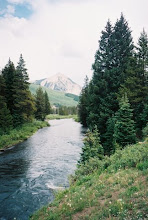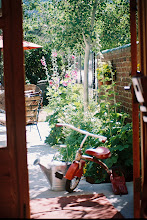Journal Entry Nineteen: Mothers Bistro
The newest gathering place in Buena Vista is Mothers Bistro. They boast of having “light” fare, so if you are craving a hot, chicken fried steak, mashed potatoes with gravy, and pie a la mode, Mothers is not your place. But if you are hungry mostly for rich, friendly conversation in an outdoor courtyard, under a cool Aspen tree, this is the place for you. In the evenings during the summer weekends there are a lot of intimate, interesting musical entertainers to be found here. My hiking buddy/concert pianist’s husband has been known to frequent here and grace us with his stunning playing of his flute. Their daughter is also a regular here with her rich, warm cello. One of the more unusual set of nightly entertainers though, played a variety of unique instruments. This husband - wife team were a part of the local farmers in town. They have a small farm where the locals love to order fresh cow’s milk, yogurt, butter, and various vegetable and fruits. But, unlike the rest of us, their evening entertainment is to sit around the farm and sing and play instruments together. This night he played several instruments. One was a delightful white Aspen didgjouridou. This is an Australian instrument that is usually four to five feet in length and cylindrical in appearance. It is commonly spelt ‘didgeridoo’ and is called a yidaki of the local Aboriginal people in Northern Australia where it originated. It has been part of the Aboriginal culture for thousands of years.
What makes this device unique is how hard it is to play. The musician must use circular breathing, which is very hard to learn. This ‘circular breathing’ is a technique in which the mouth cavity is filled with air and closed at the soft palate to sustain the sound while a quick breath is taken in through the nose. This process allows for the sound of the instrument to be continuous. This man also played the fiddle sticks on the neck of the banjo his wife was playing. It took a lot of courage and trust on her part, as his fiddle sticks came dangerously close to her nimble fingers. The one instrument he played that I had never seen was called a Limber Goose.
This was a wooden musical instrument which consists of a goose with loose joints on the end of a long stick, the legs of which the performer causes to tap rhythmically on a thin wooden board as if clogging. There are different versions also, instead of a limber goose. Sometimes you may see a limber jack, or limber horse or a raggedy man. These are all percussion instruments used in folk music to tap out rhythms, often played with old-time string band music. The realistic dancing motions produced by these instruments were a pre-cursor to “clogging”, both of which are popular dance styles in the Appalachian region.



No comments:
Post a Comment